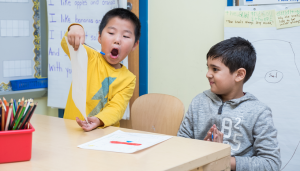Video 1: Why I Write
Jacqueline Woodson talks about why she writes, her process, and why it’s important for us all to share our words.
Journal or Discussion Prompt Suggestions:
- Why do you think Jacqueline Woodson became a writer?
- Why are you a writer?
- What do you wish you could write about?
Related Writing Activities:
Why-I-Write Wall
Cover a large wall with a sheet of paper and write WHY I WRITE in the middle. Invite students to write their own responses to this prompt on the paper. If they are not yet able to write, have them draw their responses.
Writer’s Self Portrait
Invite students to draw a picture of themselves as writers. Ask them to show:
- Where they write
- What they are writing with
- What they are writing about
Video 2: Writing = Hope x Change
Jacqueline Woodson explains the “equation” that fuels her work and how it plays out in the books she writes. She reads an excerpt from Each Kindness and points to the moment of change in that story that propels it forward. She concludes with a call to action, inviting us all to tell our stories of hope and change.
Journal or Discussion Prompt Suggestions:
- What did this video make you wonder?
- Tell the story of a time when you changed your mind about something. What made you change your mind?
- How do you show the world what you think?
Related Writing Activities:
3 Words, 3 Pictures
While the concept of Woodson’s “equation” may not be developmentally appropriate for younger students, a reflection on each of the words within it can build understanding. Using this reflection template, students draw a picture of or write about what each word means to them.
Posting Positive Messages
 Consider reading Each Kindness in full and reflecting as a class on what the narrator could have done to treat Maya differently and make her feel welcome. Writing with chalk on sidewalks or writing on sticky notes that can be posted around the school, students compose short statements of kindness that they can share with others. Messages might include things like: “You are welcome here.” “I’m glad you are in my class.” “I like learning with you.”
Consider reading Each Kindness in full and reflecting as a class on what the narrator could have done to treat Maya differently and make her feel welcome. Writing with chalk on sidewalks or writing on sticky notes that can be posted around the school, students compose short statements of kindness that they can share with others. Messages might include things like: “You are welcome here.” “I’m glad you are in my class.” “I like learning with you.”
Video 3: What will your words change?
Jacqueline Woodson shares an excerpt from her most recent book Harbor Me, centered on a group of middle school students, and discusses how as writers we can create change by questioning the narrative we see around us and sharing the truth of our own stories.
Journal or Discussion Prompt Suggestions:
- What’s something you want to change at school, in your neighborhood, in your community, or in the world? Why?
- How can writing help you in your daily life?
Related Writing Activities:
Sign Making
Show students examples of several signs that help people understand what to do about a problem (for instance, don’t litter, recycle, pick up after your dog, no running in the hallway). Give students a large piece of paper and have them write and illustrate a poster about something they want to change.
Comic Strip
Invite students to write and/or illustrate a comic strip that tells a personal story about a problem they solved. Check out ReadWriteThink’s Comic Creator for an online tool or use this sequence of events chart.

 Taking time to talk about writing and to celebrate the power of our words can build enthusiasm and confidence in students’ own voices and launch a conversation around what writing can do. While Jacqueline Woodson is speaking especially to middle level students in her videos, her message is universal. In videos 2 and 3 she reads excerpts from her books, so even if your students are not familiar with her work they will get to listen to some of her writing. Her
Taking time to talk about writing and to celebrate the power of our words can build enthusiasm and confidence in students’ own voices and launch a conversation around what writing can do. While Jacqueline Woodson is speaking especially to middle level students in her videos, her message is universal. In videos 2 and 3 she reads excerpts from her books, so even if your students are not familiar with her work they will get to listen to some of her writing. Her